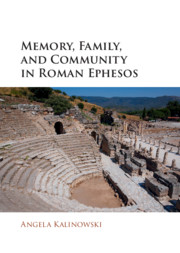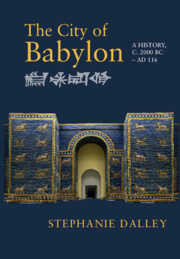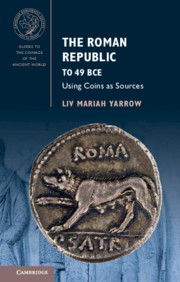Refine search
Actions for selected content:
23990 results in Ancient history
Conventions
-
- Book:
- The City of Babylon
- Published online:
- 23 June 2021
- Print publication:
- 08 July 2021, pp xv-xv
-
- Chapter
- Export citation
Illustrations and Maps
-
- Book:
- The City of Babylon
- Published online:
- 23 June 2021
- Print publication:
- 08 July 2021, pp vii-xii
-
- Chapter
- Export citation
Timeline
-
- Book:
- The City of Babylon
- Published online:
- 23 June 2021
- Print publication:
- 08 July 2021, pp xvi-xix
-
- Chapter
- Export citation
5 - From the Great Rebellion to the End of the First Dynasty, c. 1732–1592
-
- Book:
- The City of Babylon
- Published online:
- 23 June 2021
- Print publication:
- 08 July 2021, pp 106-131
-
- Chapter
- Export citation
Contents
-
- Book:
- The City of Babylon
- Published online:
- 23 June 2021
- Print publication:
- 08 July 2021, pp v-vi
-
- Chapter
- Export citation
Appendix: Genesis 14:1–16 and Possible Links with Foreign Rulers Early in the Reign of Hammurabi
-
- Book:
- The City of Babylon
- Published online:
- 23 June 2021
- Print publication:
- 08 July 2021, pp 319-321
-
- Chapter
- Export citation

Memory, Family, and Community in Roman Ephesos
-
- Published online:
- 06 July 2021
- Print publication:
- 15 July 2021

The City of Babylon
- A History, c. 2000 BC – AD 116
-
- Published online:
- 23 June 2021
- Print publication:
- 08 July 2021

The Roman Republic to 49 BCE
- Using Coins as Sources
-
- Published online:
- 22 June 2021
- Print publication:
- 06 May 2021
-
- Textbook
- Export citation
Chapter 4 - Slaves and Status
-
- Book:
- Slaves and Slavery in Ancient Greece
- Published online:
- 08 June 2021
- Print publication:
- 10 June 2021, pp 161-199
-
- Chapter
- Export citation
Bibliographical Essay
-
- Book:
- Slaves and Slavery in Ancient Greece
- Published online:
- 08 June 2021
- Print publication:
- 10 June 2021, pp 252-254
-
- Chapter
- Export citation
Index
-
- Book:
- Slaves and Slavery in Ancient Greece
- Published online:
- 08 June 2021
- Print publication:
- 10 June 2021, pp 271-278
-
- Chapter
- Export citation
Chapter 3 - Being a Slave
-
- Book:
- Slaves and Slavery in Ancient Greece
- Published online:
- 08 June 2021
- Print publication:
- 10 June 2021, pp 102-160
-
- Chapter
- Export citation
Map of ancient Greece and the Mediterranean region
-
- Book:
- Slaves and Slavery in Ancient Greece
- Published online:
- 08 June 2021
- Print publication:
- 10 June 2021, pp xvi-xviii
-
- Chapter
- Export citation
Copyright page
-
- Book:
- Slaves and Slavery in Ancient Greece
- Published online:
- 08 June 2021
- Print publication:
- 10 June 2021, pp vi-vi
-
- Chapter
- Export citation
Chapter 2 - Becoming a Slave
-
- Book:
- Slaves and Slavery in Ancient Greece
- Published online:
- 08 June 2021
- Print publication:
- 10 June 2021, pp 52-101
-
- Chapter
- Export citation
Contents
-
- Book:
- Slaves and Slavery in Ancient Greece
- Published online:
- 08 June 2021
- Print publication:
- 10 June 2021, pp ix-ix
-
- Chapter
- Export citation
Figures
-
- Book:
- Slaves and Slavery in Ancient Greece
- Published online:
- 08 June 2021
- Print publication:
- 10 June 2021, pp x-xi
-
- Chapter
- Export citation
Chapter 1 - Approaching Slavery in Ancient Greece
-
- Book:
- Slaves and Slavery in Ancient Greece
- Published online:
- 08 June 2021
- Print publication:
- 10 June 2021, pp 1-51
-
- Chapter
- Export citation
Acknowledgments
-
- Book:
- Slaves and Slavery in Ancient Greece
- Published online:
- 08 June 2021
- Print publication:
- 10 June 2021, pp xiii-xiv
-
- Chapter
- Export citation
